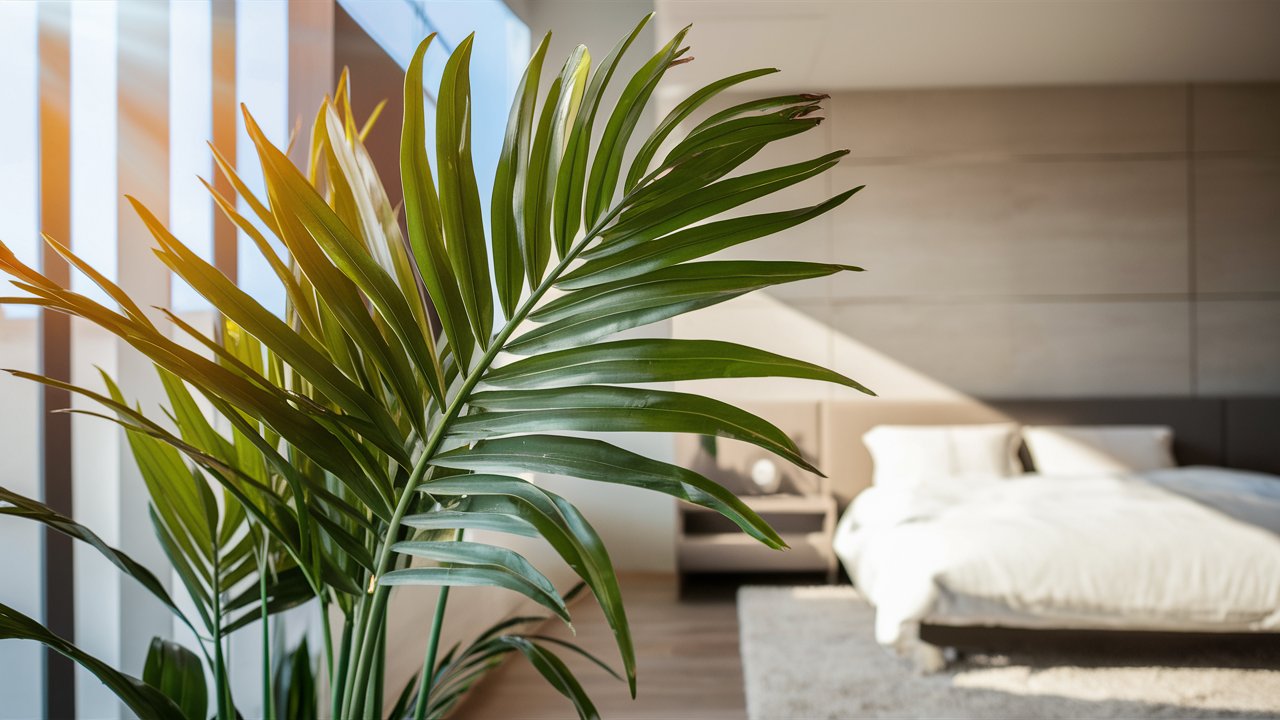Disclosure: Some links on this site are affiliate links. As Amazon Associates, we earn from qualifying purchases (at no cost to you).
Ever wondered how to transform your bedroom into a green oasis with minimal effort?
Here are 20 low-maintenance plants that not only beautify your space but also improve air quality and promote better sleep. If you enjoy these decor ideas, make sure to pin them to your Pinterest boards!
20 Easy-Care Bedroom Plants
1. Snake Plant (Sansevieria trifasciata)

Snake plants are incredibly resilient and known for their striking, upright leaves. They are excellent at filtering indoor air, removing toxins like formaldehyde and benzene. They thrive in low light and require minimal watering, making them ideal for the bedroom. Place a snake plant in a sleek, modern pot on your bedside table or in a corner to add height and greenery.
2. Spider Plant (Chlorophytum comosum)

Spider plants are easy to care for and great at removing toxins from the air. They produce small “spiderettes” that dangle from the mother plant, adding a playful touch. They thrive in indirect light and need watering about once a week. Hang a spider plant in a macramé hanger near a window to add a touch of boho chic.
3. Lavender (Lavandula)

Lavender is not only known for its soothing fragrance but also its ability to promote relaxation and improve sleep quality. It prefers bright light and moderate watering. Place a pot of lavender on your windowsill to fill your bedroom with its calming scent.
4. Aloe Vera

Aloe vera is famous for its healing properties and air-purifying abilities. It requires very little water and can thrive in indirect light. Place an aloe vera plant on your bedside table to enjoy its benefits and have a natural remedy for minor cuts and burns within arm’s reach.
5. Peace Lily (Spathiphyllum)

Peace lilies are elegant plants with dark green leaves and beautiful white flowers. They are great at removing toxins from the air and thrive in low to medium light. Place a peace lily on a dresser or a shelf to add a touch of elegance and improve air quality.
6. English Ivy (Hedera helix)

English ivy is a trailing plant that can reduce airborne mold and improve air quality. It prefers indirect light and regular watering. Hang an English ivy plant in a basket near a window or let it trail down a bookshelf to create a lush, green cascade.
7. Gardenia

Gardenias are known for their fragrant white flowers and glossy green leaves. They prefer bright, indirect light and consistent moisture. Place a gardenia plant on a nightstand or a windowsill to enjoy its lovely fragrance and add a touch of elegance to your bedroom.
8. Jasmine (Jasminum)

Jasmine has sweet-smelling flowers that can help reduce anxiety and promote restful sleep. It prefers bright light and regular watering. Place a jasmine plant near your bed or on a windowsill to enjoy its calming scent.
9. Chinese Evergreen (Aglaonema)

Chinese evergreens are hardy plants that can tolerate low light and irregular watering. They are excellent at removing toxins from the air. Place a Chinese evergreen on a low shelf or a side table to add a pop of green and improve indoor air quality.
10. Golden Pothos (Epipremnum aureum)

Golden pothos are very low-maintenance and are great for purifying the air. They thrive in low light and require minimal watering. Hang a golden pothos in a basket or place it on a high shelf to let its vines trail down and add a touch of greenery.
11. Boston Fern (Nephrolepis exaltata)

Boston ferns add humidity to the air and help filter out toxins. They prefer indirect light and consistent moisture. Hang a Boston fern in a corner or place it on a plant stand to enjoy its lush foliage and improve air quality.
12. Areca Palm (Dypsis lutescens)

Areca palms are great for removing carbon dioxide and increasing humidity. They thrive in bright, indirect light and require regular watering. Place an areca palm in a decorative pot in a corner to add a tropical feel to your bedroom.
13. Rubber Plant (Ficus elastica)

Rubber plants are excellent for improving air quality and adding greenery. They prefer bright, indirect light and need watering when the top inch of soil is dry. Place a rubber plant in a stylish pot on the floor or a low table to make a bold statement.
14. Gerbera Daisy (Gerbera jamesonii)

Gerbera daisies filter toxins and add a pop of color with their bright flowers. They prefer bright light and regular watering. Place a gerbera daisy on your windowsill or a sunny spot to enjoy its cheerful blooms.
15. Philodendron

Philodendrons are low-maintenance plants that filter out harmful chemicals. They thrive in low to medium light and require minimal watering. Place a philodendron on a shelf or let it trail down a bookcase to add lush greenery.
16. ZZ Plant (Zamioculcas zamiifolia)

ZZ plants are tough and survive in low light and with infrequent watering. They are great for filtering the air. Place a ZZ plant in a modern pot on your dresser or a low table to add a touch of greenery with minimal effort.
17. Bamboo Palm (Chamaedorea seifrizii)

Bamboo palms add humidity and remove toxins like formaldehyde. They thrive in bright, indirect light and require regular watering. Place a bamboo palm in a decorative pot in a corner to add a tropical vibe to your bedroom.
18. Chamomile

Chamomile is known for its calming effects and pleasant aroma. It prefers bright light and moderate watering. Place a chamomile plant on your windowsill to enjoy its soothing benefits and delicate flowers.
19. Rosemary

Rosemary enhances memory and air quality with its aromatic leaves. It prefers bright light and moderate watering. Place a rosemary plant on a sunny windowsill or a kitchen counter to enjoy its fragrance and culinary benefits.
20. Orchid (Orchidaceae)

Orchids have beautiful blooms that add elegance and purify the air. They prefer indirect light and moderate watering. Place an orchid on your nightstand or a windowsill to enjoy its stunning flowers and improve indoor air quality.
Which Plants Would We Choose?
Choosing the right plants for your bedroom depends on your personal preferences and the specific conditions of your room.




If you prefer a plant that requires minimal effort, Snake Plant and ZZ Plant are excellent choices due to their resilience and low light tolerance. For a fragrant addition that promotes relaxation, Lavender or Jasmine could be ideal.
If you’re looking to add a touch of elegance and color, Orchids and Gerbera Daisies are perfect for brightening up your space. Consider the lighting, humidity, and your lifestyle when selecting the best plants for your bedroom sanctuary.
FAQ
Q: How often should I water these plants?
A: Most of these low-maintenance plants, like the Snake Plant and ZZ Plant, only need watering every 2-4 weeks. Plants like Spider Plant and Peace Lily require more frequent watering, about once a week.
Q: Do these plants need a lot of sunlight?
A: Many of these plants, such as the Snake Plant and ZZ Plant, thrive in low to medium light conditions. However, plants like Lavender and Jasmine prefer bright, indirect sunlight.
Q: Are these plants safe for pets?
A: Some of these plants, like the Rubber Plant and Peace Lily, are toxic to pets if ingested. It’s best to keep them out of reach of pets or choose pet-safe options like Spider Plant.
Q: Can these plants really improve air quality?
A: Yes, many of these plants, such as Snake Plant, Spider Plant, and English Ivy, are known for their air-purifying abilities, removing toxins and improving indoor air quality.
Q: How do I know if my plant is overwatered?
A: Signs of overwatering include yellowing leaves, mushy stems, and moldy soil. It’s important to let the soil dry out between waterings for most of these plants.
Q: Can I keep these plants in the bathroom as well?
A: Yes, plants like the Boston Fern and Bamboo Palm thrive in humid environments and can be great additions to bathrooms as well as bedrooms.
Final Thoughts
Incorporating low-maintenance plants into your bedroom not only enhances your décor but also provides numerous health benefits, from improving air quality to reducing stress and promoting better sleep. By choosing the right plants and placing them strategically, you can create a tranquil and refreshing sanctuary in your home. Whether you’re a novice or an experienced plant parent, these 20 bedroom plants offer a perfect blend of beauty and practicality.


